There's something mystical about Waterloo. The last great battle. The end of an Empire. A new Europe. Each time I visit the battlefield, I learn something new, find another answer to the many questions I have, or just enjoy walking the fields, steeped in history.
This year's visit to the battlefield had a number of purposes. My old friend, Derek Saunders, Vice President of the Waterloo Committee, wanted to set the ball rolling about rebuilding the well at Hougoumont, and also to check access arrangements to a Waterloo tomb when future rebuilding is to be carried out at Joli Buis.
My son in law, Ian Johnson, after repeatedly borrowing my books on Waterloo (and not returning them!), now wanted to see the battlefield for the first time, and as he was able to get a good exchange rate for us all, it was thought to be a good idea for him to come along. Eric Brayne, my confidante and drinking partner, alcohol abuser and Napoleonic historian, also wanted to accompany us to make another of his visits to the fields, and, of course, to obtain more duty free supplies of alcohol.
Ian, Eric and myself set off from the Midlands and made excellent progress, trying one of the disgusting meals near Junction 12 of the M1, and made it to the M25, where, on the north side of the Dartford Bridge, a Porsche decided to overtake everybody, then had a fight with the central reservation barrier, and came off worse. After we had admired this drivers driving skills and instant car customising process, we sat in the queue for a restful hour or so while the emergency services picked up the pieces.
Arriving at Derek's house in the late evening, after Eric persuaded us to stop at a pub, we were welcomed by Derek and his wife, Dorothy, who always makes us welcome. After plenty of chat Derek was loaded up, and the four of us headed for the Ramsgate-Ostend ferry.
Night Crossing
On board, we settled down for the night crossing. We left Eric loitering outside the duty-free shop asking passengers if they really wanted their duty free allowance, and this occupied his time during most of the crossing. Ian, Derek and myself caught up on all the latest gossip on Waterloo, and stopped three Germans fighting over what we thought was the weather, until Derek explained that 'Donner and Blitzen' is not really about thunder. By the way, Derek, who is probably the national expert on Waterloo (although he won't say so, not like others I know!) has his own Waterloo museum at Broadstairs. It contains a wealth of memorabilia, relies, battle plans, model lay-outs and uniforms all relating to the battle. If you are in the area, don't miss it.
On docking at Ostend early in the morning of Day One, after much discussion as to why we should drive on the right, and the driving habits of those foreign drivers, we set off for the motorway network to Waterloo, arriving mid morning for a hearty breakfast.
We had already decided we did not need headlight deflectors, as we would walk to the bar at night! Eric has many cost cutting ideas like this.
Hougoumont
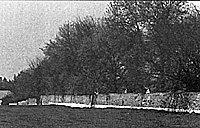 At right, Hougoumont's east wall.
At right, Hougoumont's east wall.
Our first stop was at Hougoumont. The farmer and his wife are old friends of Derek's, and it was really good to see them again. The well in the courtyard was excavated and cleared some years ago by Derek, but is only at ground level, being covered at the moment by a metal grille. This is the well that Victor Hugo said was filled by dead and dying soldiers. Please note that Derek never found one down there. The walls and dovecote above, which would restore it to its condition at the time of the battle, need rebuilding, and, as stated before, Derek's visit was to start the process of gaining permission to start construction.
We all fully explored Hougoumont with the farmer, and, to Ian's delight, Derek gave him a blow by blow account of the days fighting in and around the farm.
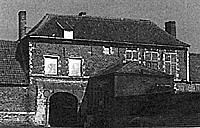 At right, Hougoumont's south gate.
At right, Hougoumont's south gate.
We also found the old tree by the South gate where, some years ago, Derek had stood a cardboard cut-out of Napoleon in front of it and used it for musket practice. The musket balls had all been dug out, obviously by visitors, who must have thought they had made a terrific find. Little do they know!
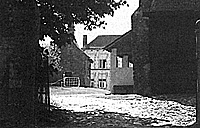 At left, Hougoumont's north gate.
At left, Hougoumont's north gate.
There is a misunderstanding by a number of Waterloo Historians regarding the design and use of The Hougoumont Farm. It has often been referred to as a fortified farm, but, in actual fact, this is not true. The garden wall on the South side would require at least 60-80 troops to give full defensive coverage along the wall, and the Eastern garden wall only continues for three quarters of the way to the sunken lane. This part wall would need probably an additional 30 troops, making an approximate requirement for 90-100 troops just to defend these areas.
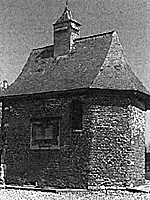 At right, Hougoumont's Chapel.
At right, Hougoumont's Chapel.
There is, and never was, any accommodation at Hougoumont for housing such numbers of troops that would have been required if those walls were intended to have been defended.
The other point is that as the Eastern wall is not complete, and there is no Northern wall at all, again this confirms the fact that Hougoumont was never intended to be a fortified farm.
Lion Mound
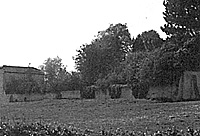 At right, Papelotte Farm.
At right, Papelotte Farm.
While Derek stayed at Hougoumont, Ian, Eric and I set out for the Lion Mound. After a quick look at the souvenir shops (still very tacky), Eric took photographs of the nearby monuments, and we walked along the Chemin D'Ohain and down into Papelotte, as far as the farm. It was a hot day and the walk was tiring, but I was sure there was a bar just past the farm. Ian ran on, and returned with a frown. No, there was not one. We walked back up the ever steepening field in silence and eventually made a successful attack on the bar opposite the Panorama, ensuring the Patron had enough money, when we left, to enjoy an expensive holiday anywhere in the world. Derek arrived in the car, so we retraced our journey just to check if Ian was really right. He wasn't. Just round the corner was a lovely bar, just waiting for thirsty walkers. We drove to our hotel at Nivelle in silence.
On the serious side, we made a quick detour to Mont-Saint Jean farm to show Ian the British Field Hospital. It really was sad to see the main gate and tower still collapsed, and no effort made to rebuild this important building. Our hotel was very welcoming. Eric tested all the beers, and eventually found one he assured us was just superb.
After a long day we all slept well.
Back to Table of Contents -- First Empire #37
Back to First Empire List of Issues
Back to MagWeb Master Magazine List
© Copyright 1997 by First Empire.
This article appears in MagWeb (Magazine Web) on the Internet World Wide Web. Other military history articles and gaming articles are available at http://www.magweb.com